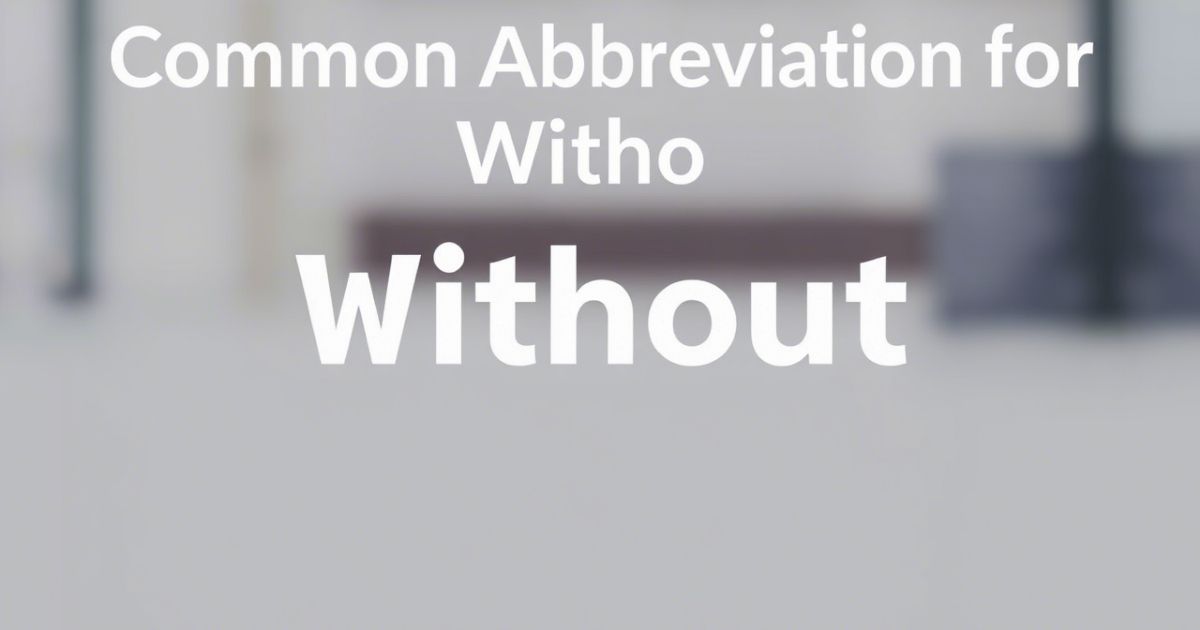Looking for a quick way to write “without”? The abbreviation for without is a simple and effective tool that helps speed up communication. Whether you’re texting a friend, writing a quick note, or even drafting an email, using w/o as a short for without makes your writing more efficient. This without shorthand is widely accepted in informal settings, saving time and space without losing meaning.
The abbreviation for without is a great way to abbreviate without when you need to keep things brief. In everyday writing, w/o is the easiest and most common way to write without shortened. It’s a handy tool for making your message clear and concise. But remember, in formal writing, it’s best to avoid abbreviations like this. Understanding how to use the abbreviation for without properly will make your communication smoother and more to the point.
What is the Abbreviation for Exclusion?
The most common abbreviation for “exclusion” is excl. This abbreviation is often used in business documents, reports, and technical writing to indicate the absence or removal of something.
Using excel. helps to keep writing short and clear, especially in lists, instructions, and specifications.
Examples of excl. in Use:
- “The price is exceptional. taxes.”
- “This offer is valid excel. weekends.”
- “The package includes all features except. premium services.”
As you can see, excl. makes writing more efficient while keeping the meaning clear. It is a useful tool for both formal and informal writing, helping with writing efficiency and communication.
What Does Abbreviation for Without Mean?
The Abbreviation for Without is w/o. It’s a short way to write the word “without.” The Abbreviation for Without helps to save time and space in writing. Here are some ways it can be used:
- Absence: “She is coming w/o her brother.” (This means “She is coming without her brother.”)
- Lack of Something: “We can’t make the cake w/o sugar.” (This means “We can’t make the cake without sugar.”)
- Exclusion: “You can join the team w/o paying a fee.” (This means “You can join the team without paying a fee.”)
In these examples, w/o shows the idea of something missing, not included, or absent.
Why Use the Abbreviation for Without?

The Abbreviation for Without, w/o, is used to make writing easier and faster. It saves time, especially when you need to write quickly or keep things short. Here are some places where you might use it:
- Text messages: “I can meet you w/o any problem.”
- Casual writing: “Please write the report w/o errors.”
- Business documents: “The order is w/o any extra charges.”
In all these cases, using w/o makes your writing faster and clearer.
Short Abbreviation for Without
The most common short abbreviation for without is w/o. This is already a very short way to write “without.” There aren’t any shorter forms of w/o, and making it shorter could confuse people.
Since w/o is already short and easy to understand, it’s best to use it to avoid mistakes. This keeps your writing clear and simple.
For example, you would write:
- “Please send the form w/o delay.”
- “I like my coffee w/o sugar.”
In these examples, w/o is short and clear for everyone to understand.
Acronym for Without
An acronym is a short form of a phrase made by using the first letters of each word. However, “without” does not have a formal acronym.
For example, “NASA” is an acronym for National Aeronautics and Space Administration. But for without, the abbreviation w/o is used instead of an acronym.
In some technical fields, you might see w/o used in phrases like “w/o changes” or “w/o problems.” These are not formal acronyms but just short ways to write the word without.
How to Pronounce Abbreviation for Without
The word “without” is pronounced as wih-THOUT. It’s important to say the second part of the word, “THOUT,” clearly.
When you say w/o, you pronounce it as “without” in full. People usually don’t say the letters w/o separately. Instead, they say the full word, without.
For example:
- Written: “Please complete the task w/o mistakes.”
- Spoken: “Please complete the task without mistakes.”
When pronouncing without, just focus on saying it clearly, especially when you are speaking quickly.
Short Abbreviation for Without

The short abbreviation for “without” is w/o. This is the most common way to write “without” in a shorter form. It is already short and easy to use, so there is no need to shorten it further. Trying to make it even shorter could make it confusing or unclear to people.
For example, instead of writing “without,” you can simply use w/o to save space and time. You will see this abbreviation in emails, notes, and business documents. Here are some examples:
- “I prefer my coffee w/o sugar.”
- “Please complete the task w/o delay.”
In all these cases, w/o is a quick and easy way to say “without”.
Synonyms for Without
If you want to use different words instead of without abbreviations, you can try using synonyms. Synonyms are words that have a similar meaning. Here are some synonyms for without:
- Lacking: “The box is lacking a lid.”
- Devoid of: “The room was devoid of furniture.”
- Absent: “He was absent from the meeting.”
- Not having: “She is not having any breakfast.”
Using these synonyms can help make your writing more interesting and varied. For example, instead of saying, “I can’t go without my keys,” you could say, “I can’t go without my keys” or “I can’t go without having my keys.”
Each synonym gives a slightly different meaning, so you can choose the best one depending on what you want to say.
Related Guide:
Abbreviation for Container Quick Reference Guide
Antonym for Without
The opposite of without is with. While without means something is missing or not included, which means that something is included or present.
Here are some examples:
- “I’ll have my coffee with cream.” (This means cream is included in the coffee.)
- “You can attend the meeting with your colleagues.” (This means you can join the meeting with other people.)
By using with, you show that something is included, whereas without shows something is missing. These two words are opposites, and they help us understand whether something is there or not.
The History of the Word Abbreviation for Without
The word without has an interesting history. It comes from the Old English word wita, which meant outside or out of. Over time, it changed and became the word without that we use today, but it still keeps the same meaning of absence or exclusion.
Languages change and evolve over time, and the word without is a good example of how language grows. Even though it has changed a lot over many centuries, it still keeps its main purpose: to show that something is missing or not included.
Understanding the history of words like without helps us appreciate how language can adapt and change while still keeping its original purpose.
Short Abbreviation for Without
The short abbreviation for “without” is w/o. It’s a quick and easy way to write without, especially when you want to save time or space. This abbreviation is commonly used in informal writing, technical writing, and quick notes.
The abbreviation w/o is already very short and clear, so there’s no need to make it any shorter. In fact, trying to shorten it further could lead to confusion. It’s best to stick to the simple and well-understood w/o to make sure your writing stays clear.
When to Use the Abbreviation w/o?
You should use w/o when you want to keep your writing short and simple. Here are some good situations to use w/o:
- In Informal Writing:
When you are writing casual emails, text messages, or making quick notes, it’s okay to use w/o. It’s a way to save time and keep things simple.
- Example: “I’ll meet you w/o delay.”
- Example: “I’ll meet you w/o delay.”
- In Technical Writing:
In reports, specifications, and other business documents, using w/o helps to keep your writing concise and focused.
- Example: “The device works w/o issues.”
- Example: “The device works w/o issues.”
- In Lists or Bullet Points:
When you are making lists or writing bullet points, you can use w/o to save space and keep things neat. This is common in instructions and to-do lists.
- Example: “Complete the report w/o errors.”
- Example: “Complete the report w/o errors.”
However, in formal writing like academic papers, essays, or official documents, it’s better to spell out “without” to keep your writing professional and clear.
Examples of the Word and Abbreviations in Context
Let’s look at some examples to understand how to use both without and w/o:
- Whole Word:
“I can’t live without my phone.”
(Here, “without” is used in a full sentence.) - Abbreviation:
“The instructions are clear w/o any confusion.”
(Using w/o here makes the sentence shorter and saves space.)
These examples show how using w/o makes the sentence more concise while still having the same meaning.
Other Examples of “Without” in Use

The word without (and its abbreviation w/o) is used in many situations. Here are a few more examples:
- In Recipes:
“This cake can be made w/o eggs.”
(Here, w/o shows that eggs are not needed in the recipe.) - In Instructions:
“Please fill out the form w/o errors.”
(This means the form should be completed correctly, without mistakes.) - In Personal Preferences:
“I prefer working w/o distractions.”
(This shows that the person likes to work without interruptions.)
Why Use w/o?
The abbreviation w/o is a helpful tool in writing because it makes your sentences shorter and easier to read. Whether you’re writing a quick note, business report, or instruction list, w/o helps you get your message across quickly without losing meaning. However, make sure to use it in the right places, like informal writing or short lists. For formal writing, it’s better to use the full word “without” for a more professional tone.
FAQs
How do you abbreviate without?
The abbreviation for without is w/o. It’s commonly used in informal writing, like emails and notes, to save time and space.
What is the abbreviation for with or without?
The abbreviation for without is w/o. There isn’t a standard abbreviation for “with or without” as a combined term.
What does w/’ mean?
The symbol w/’ is not a standard abbreviation for without. It may be a typo or shorthand used informally, but it’s not widely accepted.
Does C mean with or without?
The letter C typically does not represent either “with” or “without.” Common abbreviations for “without” are w/o, not C.
What is the abbreviation for without in text?
In text, the abbreviation for without is w/o. It’s widely used in casual and technical writing to simplify sentences and save space.
Conclusion
The abbreviation for without is commonly written as w/o. It’s a without shortened form that helps to save space and time in both casual and professional writing. When you need an abbreviation for without, w/o is widely accepted and understood. Whether you’re writing notes, emails, or even technical documents, this shorthand makes communication quicker and more efficient.
The abbreviation for without is especially useful in informal settings, like texts or quick reminders. However, in formal writing, it’s better to write out the full word. Understanding the proper usage of the abbreviation for without shortened ensures clarity and ease of communication. By using w/o, you can make your sentences more concise while still conveying the intended meaning. Just remember, it’s a short for without, and using it appropriately will improve the flow of your writing.

Atlas Reid is an experienced administrator with 5 years of expertise in managing operations, streamlining processes, and ensuring efficiency. Skilled in leadership, organization, and problem-solving to drive business success.








